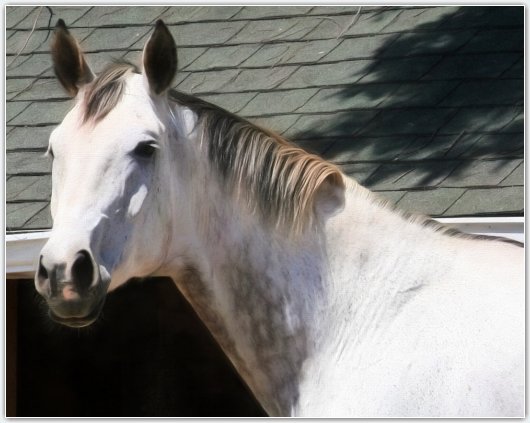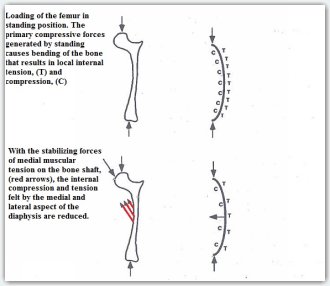Mechno-responsiveness 21
Mechanoresponsiveness Part 21
Choose Muscle Power

Hercules
Owned by Ronda Hanning
I have currently in training a very tall horse. He scales 18,3 hands with large bones and a very long neck. He is so tall that he looks down at Chazot, 18,1 hands, asking, “What happened to you, you forgot to grow?” He is indeed a very good horse. He is light like a feather with great suspension at the trot and a beautiful and well balanced canter. Circumstances have been that he did not work for six months prior is arrival and therefore lacked muscular development.
He reacted first under the saddle like a horse having a “cold back”. Instead of jumping immediately on the worse cases scenario such as “Spondylosis deformans,” we explored the thought that his reactions might be due to lack of muscle mass. Looking at a horse of this size, one would not think that such a giant should be disturbed by the weight of a light rider. In the circumstance, conventional thinking is dead wrong. The horse’s enormous skeleton demands instead, the support of a considerable muscle strength. If we focus for example on the horse’s femur.  Standing still and never the less in motion, the weight of the horse’s body bends the femur creating compression on one side of the bone and tension on the other side. The bone itself does have a system of mineral and fluid allowing greater support of compressive and tensile forces, but the muscles are part of the systems reducing the forces acting on the bone. On this diagram, the three red arrows illustrate how muscles help reducing the compressive forces loading the femur.
Standing still and never the less in motion, the weight of the horse’s body bends the femur creating compression on one side of the bone and tension on the other side. The bone itself does have a system of mineral and fluid allowing greater support of compressive and tensile forces, but the muscles are part of the systems reducing the forces acting on the bone. On this diagram, the three red arrows illustrate how muscles help reducing the compressive forces loading the femur.
Most of the joints would not be able to support the stresses created by locomotion and performances if their integrity were not reinforced by tendons attached on the joints. Proper tension of the tendons is assumed by the correspondent muscles and insufficient muscular development compromises the stability of the articulations. As explained earlier, a muscle covering several joints can absorb power at one joint and simultaneously produce power at another joint. “This function of biarticular muscles is referred to as power transport between joints”. (Gregoire and al., 1984) In the lower limbs of horses, there are several more or less tendinous bi- or polyarticular muscles. No muscles fibers are needed to transport power and tendons can also transport power. The advantage of this system is that the horse lower limbs are lightweight while the joints can still absorb considerable stresses and contribute to the propulsion. Quite obviously, all this sophisticate mechanism demands adequate muscular development and strength.
Elasticity is not created releasing muscle tone. Elasticity is directly related to muscle strength and power. One of the many benefits of high power contractions, which are referred to as “eccentric contractions,” is changing optimal length of the muscles. “Muscles are becoming more compliant via the addition of sarcomere in series, allowing muscle fibers to operate at longer lengths.” .” (Paul C. LaStayo, PT, PhD. John M. Woolf, PT, MS, ATC. Michael D. Lewek, PT. Lynn Snyde-Mackler, PT, ScD. Trugo Relch, BS. Stan L. Lindstedt, PhD. Eccentric Muscle Contractions: Their contribution to injury, prevention, rehabilitation, and sport. Journal of Orthopaedic & sports physical therapy. 557-571. Volume 33, NUMBER 10, October 2003) The elastic property of most muscles is due in large part to a cytoskeletal protein known as “Filament titin.” There are multiple titin isoforms that vary in size and stiffness. This explains the elastic-stiffness diversity in across vertebrate muscles. Filaments titin have multiple roles in striated muscles, ranging from sarcomere assembly to their most important role that is muscle spring.
Efficiency and soundness rely on muscle strength and power and therefore adequate nutrition and consistent work. One of the key findings is that light eccentric training protocols are sufficient to create the muscular adaptations explained in this discussions. This is how large horses, as well as every equine athlete, can be adequately muscled up without inducing damaging stresses on the bones and other structures. The gentle giant, as well as every horse in training, is never rushed faster than its natural cadence, never driven on the forehand, never asked any neck posture loading the forelegs. The benefits of the stretch-shorten contraction phenomenon are largely used.
We have published articles explaining the stretch-shorten contraction. Members of the course are familiar with the concept as it is the essence of techniques such as the “Pignot jog.” Basically, when muscles are working eccentrically prior to a concentric contraction, the elastic strain energy stored in the muscles and tendons during the eccentric contraction is reuse during the following concentric contraction amplifying force and power production. “The ability to recover elastic strain energy is apparently energetically so advantageous that the most economical stride frequency in running may be set by this key property alone.” (Paul C. LaStayo, and all)The concept occurs when the horse travels at its natural frequency, (cadence.) Other elements such as authentic balance and consequent lightness are necessary, but the pervasive role of eccentric muscular force enhancement prior to a power activity such as during the stretch-shorten contraction phenomenon, has to be known and understood as it prepares efficiently the horse physique for the athletic demands of modern performances, whatever the performances is jumping or dressage movements.
Effortlessness, ease, elegance, amplitude, beauty, class are subtle orchestration of well-developed and powerful muscles. Jean Luc Cornille


 twitter
twitter facebook
facebook google
google stumbleupon
stumbleupon pinterest
pinterest linkedin
linkedin